General characteristics of Pterophyta
Since Pterophyra have lignified xylem vessels and phloem vessels they belong to the vascular plants, in contrast to algae (e.g. Laminaria, Volvox, Polysiphonia) and mosses (e.g. Marchantia, Funaria). Pterophyta may also develop stems, often as rhizomes, true leaves, called frond, and -simple- roots. There are, however, no flowers in their life cycle, and thus they also lack fruits and seeds. Their sexual reproduction is done through spores. Another difference between Pterophyta and higher plants is that many species belonging to the Pterophyta have a vegetative propagation path by means of rhizomes (e.g. in bracken,
Pteridium acuilinum) or through bulblets on the leaves.
Three main groups are distinguished within the Pterophyta:
- Whisk Ferns, genus Psilotum
- Horsetails, to which Equisetum belongs
- True ferns, for example Dryopteris and Polypodium.
| Life cycles in the Pterophyta |
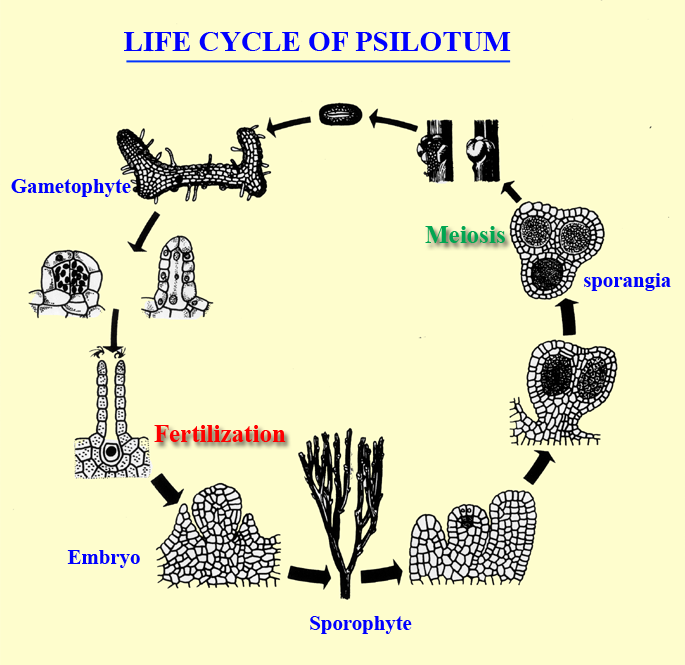 |
 |
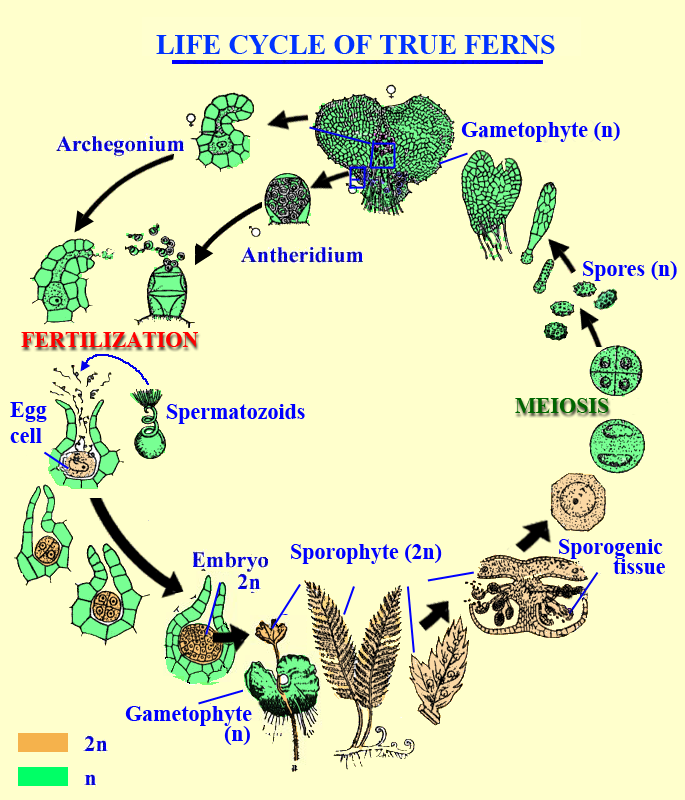 |
| Zoom view of the life cycle of Psilotum |
Zoom view of the life cycle of Equisetum |
Zoom view of the life cycle of True ferns |
Psilotum
The sporophyte of Psilotum and relatives displays a dichotomic branching stem. Plants of the genus Psilotum do not have true roots, but underground rhizomes that can take up water and nutrients from the soil.
| Habitat of Psilotum |
 |
Psilotum.
A. Habitat of the sporophyte (2n), B. Stem of the sporophyte with sporangia, C. Dichotomy of the stems (dual forked branching originating from the splitting of the growth points of the stem) D. Detail van het sporangium[/ned] |
Equisetum
Most known horsetails are fossil. Nowadays we only know the genus Equisetum. Characteristic for these plants is the articulated ribbed stem consisting of internodes fitting one on top of the other like links of a chain. At the level of the nodes (joints) a whorl of small scaly leaves forming a brush emerge. In some species "side-branches" arise from these nodes. The stem contains a single vascular trace and a central canal, surrounded by smaller cavities ans bands of cells giving strength.
At the top of the fertile stem a conus-shaped strobilus is formed from rings of sporangiophores. These consist of stalks covered with a scale that protects the sporangia. By dry weather ribbon-like appendages (elaters; see drawing here below) attached to the spore uncoil and enable a further dispersal through the wind. The spore germinates to form a prothallium. After fertilization a new sporophyte is formed.
| Sprouts and strobili in Equisetum |
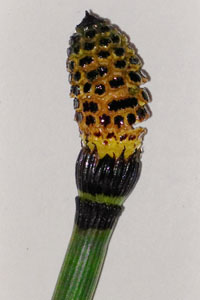 |
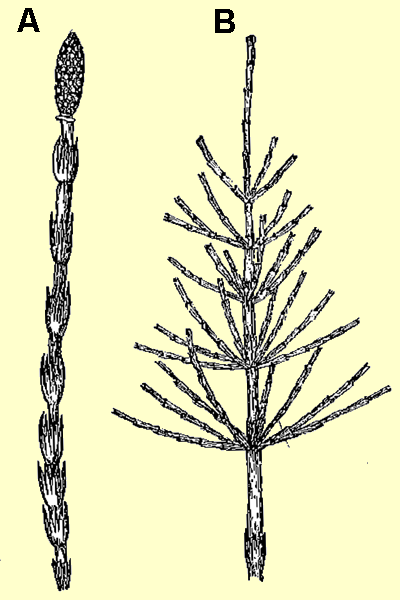 |
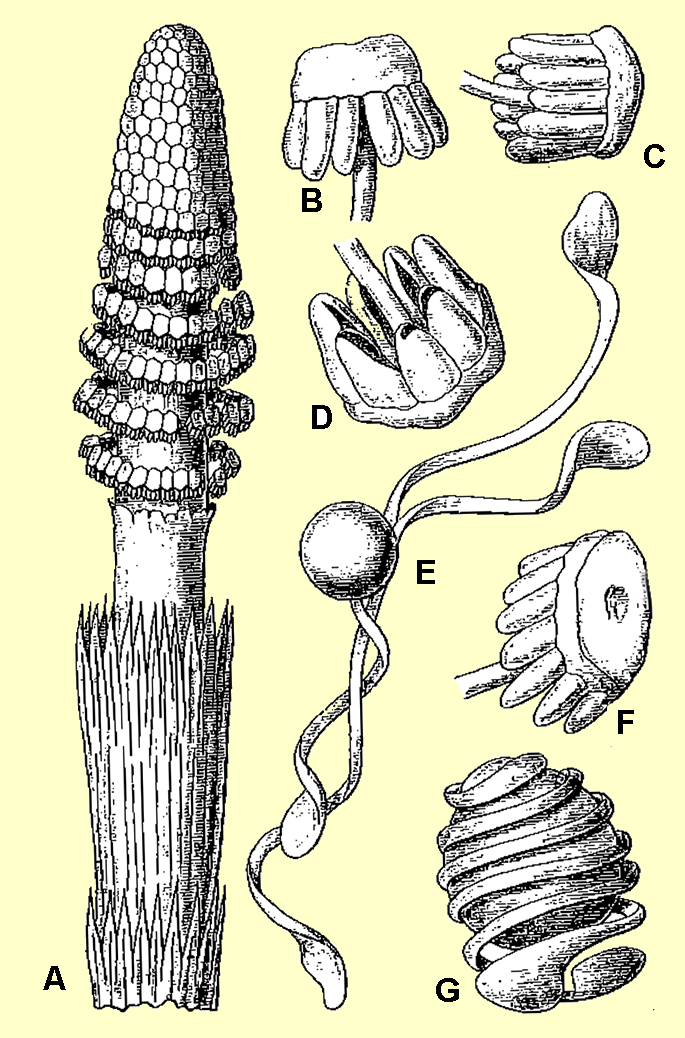 |
| Macro view of the strobilus |
Hereabove (Equisetum arvense): A fertile shoot with strobilus; B sterile (= vegetative) shoot | Shapes of strobili Equisetum telmateja: A: sporenaar, B, C, D, F Sporophyl seen from various angles, E and G spores with elaters.
Source: according to Luerssen, (1893) in K. Giesenhagen, 1903 |
True ferns
The best known stage of the life cycle of true ferns is that of the mature diploid sporophyte. The leaves, called frond, consist of a leafstalk and an often multi-pinnate leafsheets. Since the vascular system of these leaves is branching one speaks of macrophyll leaves. The stem is short in general or entirely below ground as rhizome from which roots sprout. In cross sections of the stems one can recognize an epidermis layer, cortex and central cylinder containing vascular bundles.
| Sori at the lowerr side of the front of a true fern |
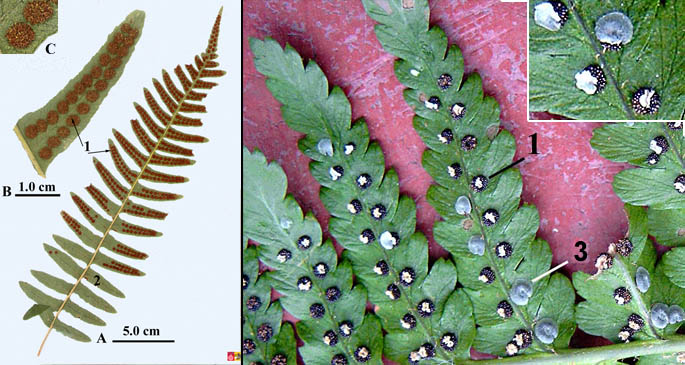 |
| 1 = sorus (plural sori = clusters of sporangia), 2 = leaflet (part of the pinnate leaf), 3 = indusium (a scale protecting the sorus |
Under some leaves one can find sometimes clusters of spores (sorus, plural sori) sometimes covered by a protective scale called indusium. Ball-shaped sporangia are formed (the sporogenic tissue) that are covered by a thick wall called annulus. Meiosis occurs in these sporangia, leading to haploid spores.
| Indusia, sori and spores in true ferns |
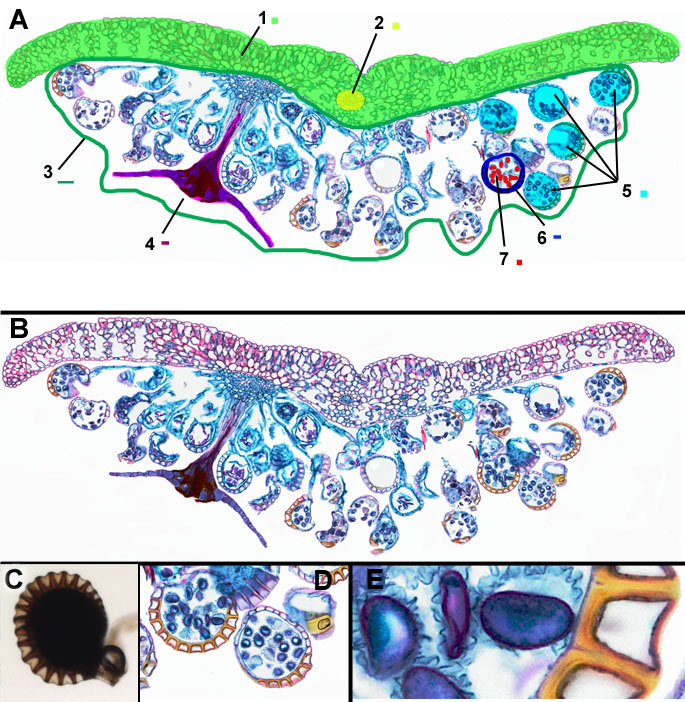 |
A and B. Cross-section through a leaflet of a true fern
1 = frond, 2 = vascular bundle, 3 = sorus, 4 = indusium (protective scale), 5 = sporangia, 6 = sporangium wall, 7 = spores
C. Detail of an entire spore
D. Detail van a section through spores.
E. Detail of the wall of a spore |
When the haploid spores start to germinate, a filamentous prothallium (n)arises. It develops through mitotic divisions of haploid cell into a tiny heart-shaped organism, not more than a few millimiters big and a few cell layers thick, but photosynthetically active (autotroph). At the base one can find long single rhizoid cells involved in the attachment of the plantlet. Nutrients and water can be absorbed directly over the entire surface.
| Germinating prothallium |
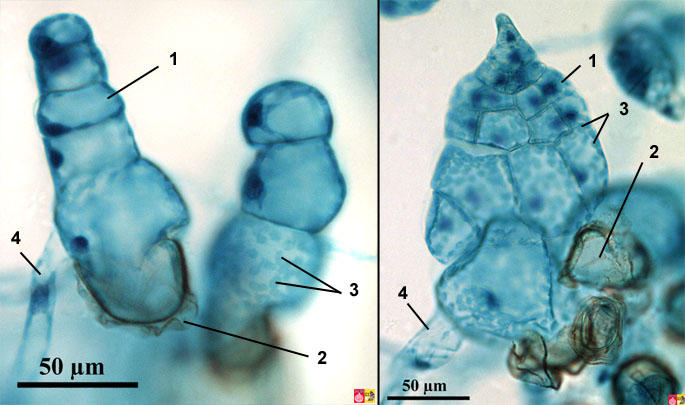 |
| 1 = young prothallium, 2 = rest of the spore wall, 3 = chloroplasts, 4 = rhizoids |
The heart-shaped haploid prothallium has a function as gametophyte: both male (antheridia) and female (archegonia) gametangia develop on it. The archegonia look like cups with a neck (neck canal) with the egg cell enclosed at the bottom of the cup. The antheridia look like spheres fully packed with rolled-up sperms. Immediately after dehiscence of the antheridia, in presence of a drop of water, the released sperms can swim with their flagellum to the egg cell. After fertilization a diploid (2n) embryo develops, which will give rise to the sporophyte.
| Prothallium of true ferns: antheridia (left) and archegonia (right |
 |
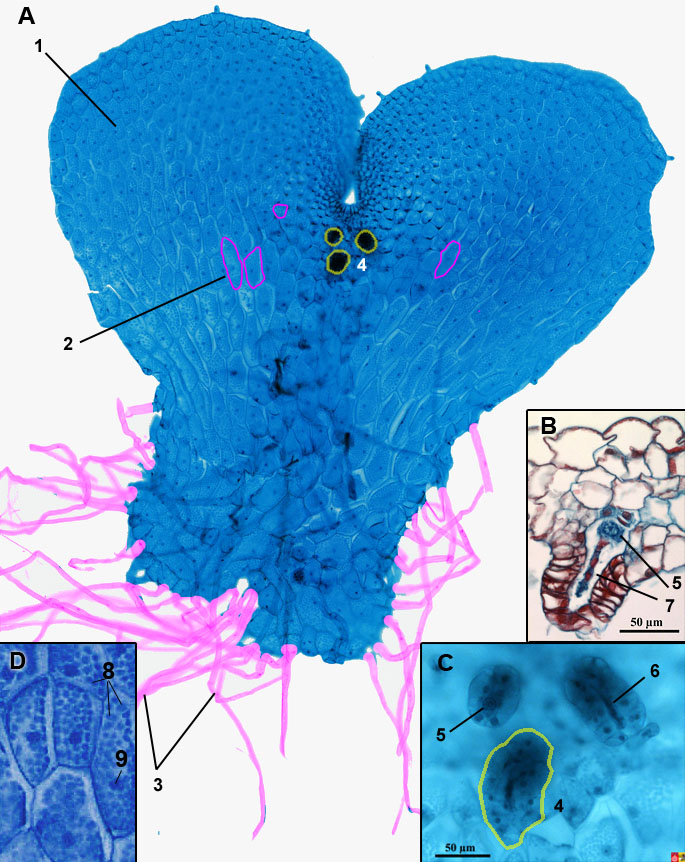 |
A - D. Prothallium with antheridia.
Zoom view of antheria and sperms.
A en B. 1 = antheridia, 2 = sperms in the antheridia
C. Detail of sperms (with flagella)
D. Detail of antheridia filled up with sperms |
A - D. Prothallium with archegonia
Zoom view of prothallium, archegonia and egg cell
A. Prothallium with archegonia
B. Detail of archegonium in a cross-section (zoom of archegoniuma, egg cell)
C. Detail of archegonia in upperview
D. Detail of prothallium cells (photosynthetic active due to chloroplasts)
1 = prothallium, 2 = prothallium cells, 3 = rhizoids, 4 = archegonia, 5 = egg cell, 6 = neck canal cells, 7 = neck canal, 8 = chloroplasts inside prothallium cells, 9 = cel nucleus |
| "Young sporophyte growing on the gametophyte in True ferns |
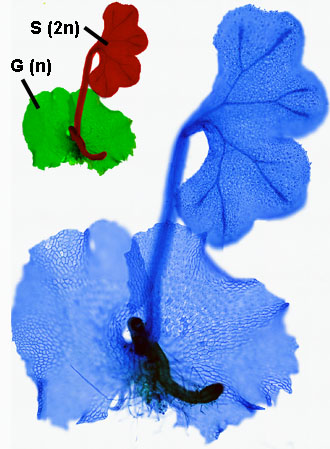 |
Resting and feeding on the haploid gametophyte (indicated by G) the diploid embryo grows out into a young -diploid- sporophyte (indicated with S), which after some time will become the typical leaf sporophyte. |







